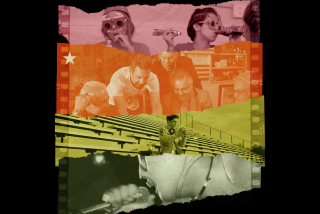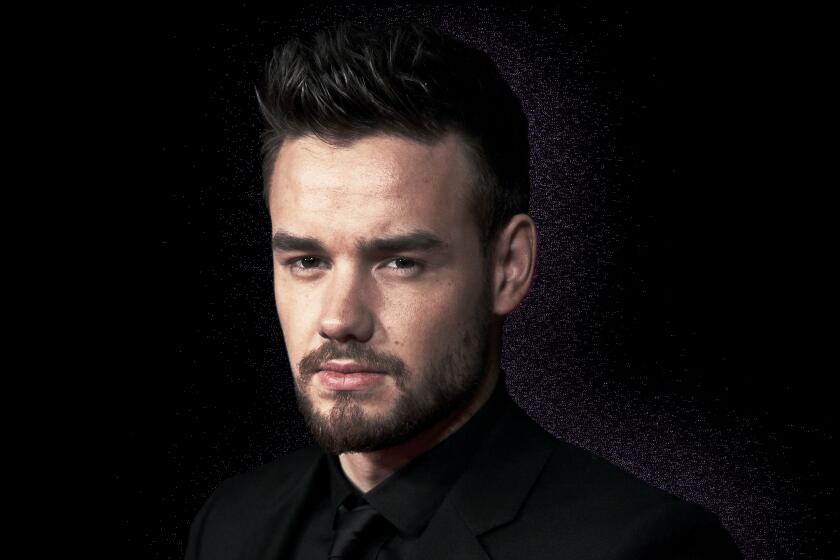Donald Glover’s not-quite-musical ‘Guava Island’ premieres at Coachella
- Share via
“Guava Island,” Donald Glover’s highly-anticipated and secretive film, made its debut on the campgrounds of the Coachella Valley Music and Arts Festival Thursday evening as attendees began settling in for the long weekend.
Directed by Hiro Murai and starring Glover alongside Rihanna, Letitia Wright and Nonso Anozie, the film is set to air widely Saturday at 12:01 a.m. on Amazon Prime Video after the artist’s headlining set under his musical moniker, Childish Gambino.
In Indio, “Guava Island” was revealed to be an exploration of life in a black diaspora working-class community. The spark for the film, said Stephen Glover, screenwriter and Donald’s brother, was an idea of Glover’s, fleshed out during a trip to Hawaii in early 2018 with members of Royalty, the creative team working with Childish Gambino and FX’s “Atlanta.”
It’s difficult to categorize the work, but that’s intentional, says the film’s producer and music supervisor, Fam Udeorji. Not quite a musical, not quite a visual album, “it’s just a representation of a specific moment,” Udeorji says. “There’s really no genre that we tied to it.”
Inspired by the 2002 Brazilian drama “City of God” and Prince’s 1984 musical drama “Purple Rain,” the team did extensive research to find a shooting location. They visited countries including Colombia and the Dominican Republic before settling on Cuba.
On Thursday evening, a pair of dancing stilt walkers in grass skirts and bold-patterned garb welcomed into the tropics the private, invite-only group attending the premiere.
Inside the “Guava Island” oasis nestled on the desert campground, a DJ played tropical versions of popular songs while people drank from coconuts and ate fruit doused with the tangy and spicy chamoy and tajín. Although many posed for photos under palm trees, the screening was a strictly “no phone” event. Everyone entering the theater was instructed to place their phones into a locked pouch that would be released later in the evening.
The theater itself, covered in red-brown metal panels and shaped like an open grain silo, created instant immersion into the world of “Guava Island.” Instead of seats, people could sit or lie on a mock grassy hill inside the silo, as the sound of crickets and birds chirping filled the space and grew increasingly loud before the film began.
“Guava Island” opens with an expositional monologue by Kofi (played by Rihanna) and an animation that introduces viewers to the fictional place “in the very center of the world.” Before switching to live action, Kofi also explains how she met her boyfriend, Deni (Glover).
As a factory worker in a garment shop, Kofi dreams of leaving the island. Deni, the ever-late musician who sings jingles on the radio for the cargo company he works for, wants to stay. Anozie plays Red, the corrupt business owner who owns both the cargo company and the garment factory. And Wright is Yara, Kofi’s friend and coworker in the factory.
With a running time of about 54 minutes, the story largely takes place in the span of a day and centers on Deni’s struggle to organize a community-wide music festival. Wearing an open shirt and shorts, Deni races through the island with his guitar, enduring run-ins with both would-be child robbers and Red. The film focuses on the quiet moments and the colors of the setting, lingering on shots of musicians and merchants or palm trees swaying by the ocean.
FULL COVERAGE: Coachella 2019 »
Deni makes time for Kofi during the day and breaks into spontaneous songs, including Glover’s hits “This is America” and “Summertime Magic” as well as new tunes. At the Coachella screening, the theater structure was a visual aid for these musical interludes.
During a scene where Deni performs a fervent “This is America” for a coworker who wants to leave the island, colorful graphics of moving gears and people working in cubicles danced on the walls outside of the screen.
Ultimately, the goal, said the creative team, was to create a feeling and tone for viewers rather than give them something purely linear.
“There’s a community even though there’s poverty and tragedy,” Stephen Glover said. “The sense of community and the sense of joy … I want to give people a little taste of that.”
More to Read
The biggest entertainment stories
Get our big stories about Hollywood, film, television, music, arts, culture and more right in your inbox as soon as they publish.
You may occasionally receive promotional content from the Los Angeles Times.










